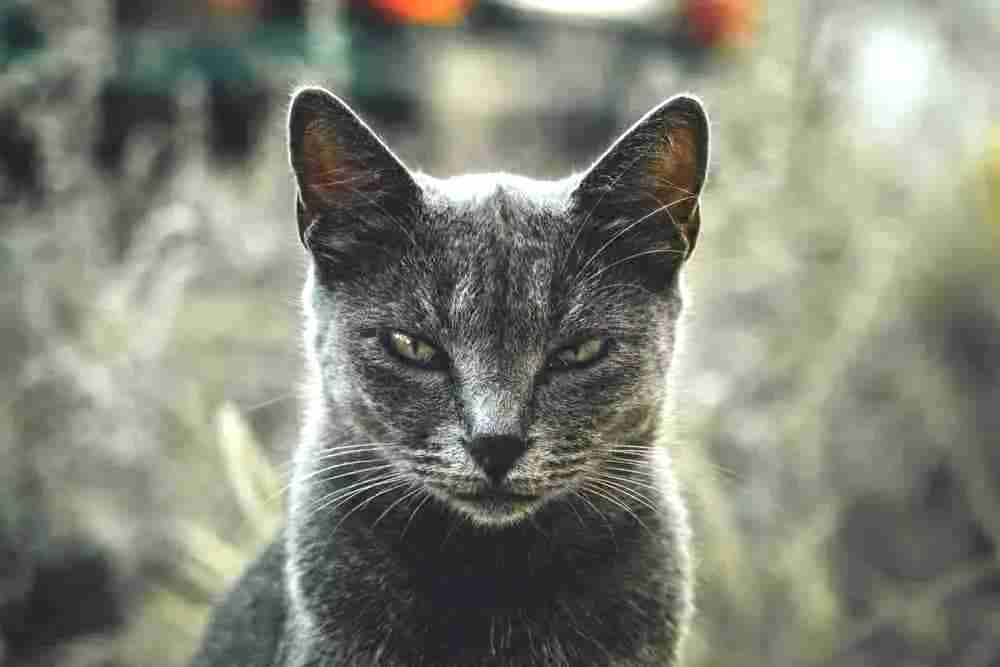Grey short hair cats are distinctive in appearance which makes them very sought after. But are they rare? Are all grey cats short hair? Are they all special breeds or can a standard domestic shorthair be found that is just plain grey?
Get the answer to these questions and more below and find out which breeds are specifically known for their blue cats.

Are Grey Cats Rare?
Grey tabby cats are relatively common. They occur naturally in domestic shorthair cats and in many purebred cats. Solid grey cats, on the other hand, are not so common.
In the cat world, the two primary coat colors are red and black with black being dominant. All other variations of pattern and color come from separate genes – these include genes for dilution, stripes, masking or piebald genes, and the like.
For a solid grey cat to occur naturally, and they do, the cat needs to be a black cat that inherits the non-agouti gene and the dilution gene. These genes remove the tabby stripe and fade the black coat to a grey or blue.
This makes it sound easy, but the rarity factor lies in the fact that the non-agouti and dilution genes are recessive genes. Genes are paired, so recessive genes only kick in if a pair of recessive genes are inherited – otherwise, a dominant gene in the pair overrides the recessive.
Think of It this way. If the tabby father passed on a non-agouti gene and an agouti gene and the mother cats did the same the odds are that the offspring would inherit the dominant agouti gene and be tabby – but the fact a kitten could inherit two recessive non-agouti genes, one from each parent, means two tabby cats could produce a none tabby offspring – the odds are long, but it is possible.
Now, to further complicate the picture, on top of inheriting the non-agouti recessive gene they would also have to inherit the recessive dilution gene at the same time, from both parents! This would produce a solid color kitten with dilution of the black coat.
So, it could be said that solid grey cats that spontaneously arise are rare – but people have had a hand in the process, and breeds that are known for solid grey cats, such as the Russian blue or Korat cat have developed from the mating of cats with both types of recessive genes. Basically, if you mate two solid grey cats you should get a full litter of solid grey kittens!

Are All Grey Cats Shorthair?
So, given we know how solid grey cats come about can we safely assume they are all going to be shorthair? Well, no. Coat color and pattern are determined by different genes to those that control hair length.
In fact, solid grey long hair cats are even rarer than short-haired grey cats! This is because long hair genes are also recessive! A long-haired cat must inherit a copy of the recessive gene from each parent to be long hair.
In fact, it is believed that only 10% of all cats in the world are long-haired due to the recessive nature of the gene! So the chances of a solid grey long hair cat are pretty long odds!
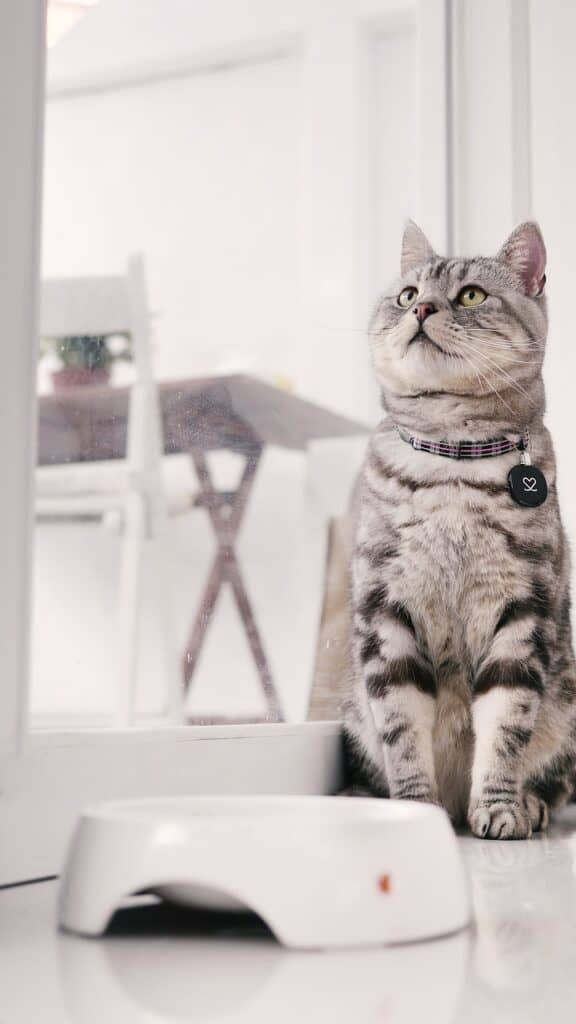
Are All Shorthair Grey Cats Purebred?
As we have alluded to, if the correct genes are inherited then a mixed breed cat, a domestic shorthair cat, can be a solid blue cat!
In fact, this situation has historically been known to occur on the island of Malta. The gene pool in Maltese cats is relatively small and the original cats on the island must have had a concentration of the relevant genes because they have produced an unnaturally high number of solid grey offspring – such that originally all solid blue cats were called Maltese cats!
These Maltese cats were not of a recognized breed, essentially they were/are domestic shorthair cats.
So you can get non-purebred cats that are solid grey in color! However, these are relatively rare (outside of Malta) so you are probably best looking for a cat from a breed that is known for producing grey shorthair cats. Check these out…
Popular Shorthair Grey Cat Breeds
The easiest way to get a solid color grey shorthair cat is to go and get a cat from a breed that is widely recognized as a breed that produces this type of cat.
There are currently six very popular cat breeds that can cater for this type of cat and they are popular enough that finding a kitten locally to yourself shouldn’t be the equivalent of the search for the holy grail!
Check these cats out…
British Shorthair Cat
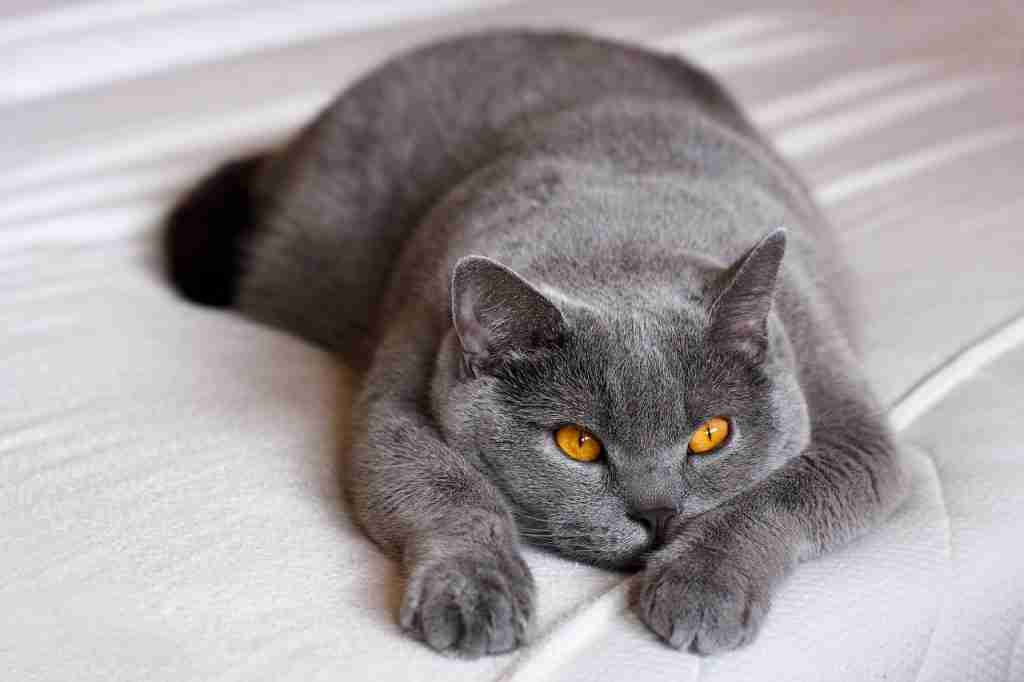
The British shorthair cat was reputedly imported to Britain by the Romans. It achieved ongoing popularity and established itself thanks to its efficient hunting skills and ability to endear itself to people.
This is a cat with a distinctive look. It is a robust, muscular, mid-size cat that has a powerful torso and short stocky legs. It has a face with large cheeks that gives the appearance that it is smiling! The coat is plush and thick making it able to adjust to cold weather well.
The British shorthair comes in a wide variety of color and pattern options. Grey and white tabby, ginger tabby, and various bi and tri-color options are available but the breed is best known and widely recognized for its solid grey cats – hence in some quarters, the breed is actually called the British blue.
They are friendly, family cat who is always watchfully lurking nearby. They are not necessarily a lap cat but like a bit of fuss until they are done. They have a reputation for being slightly aloof but are loyal cats.
Chartreux Cat
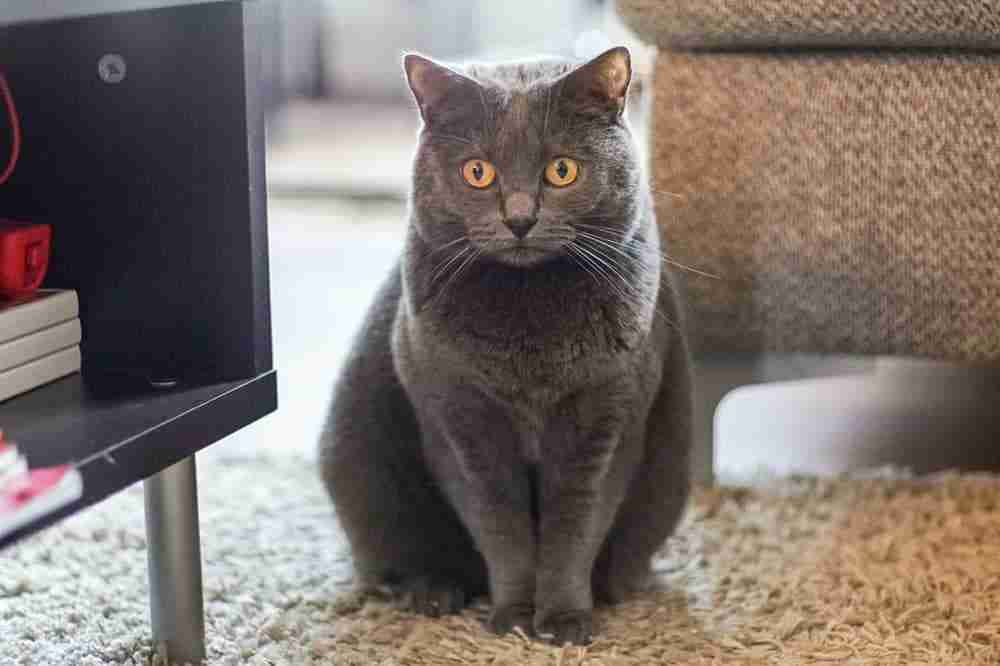
The grey Chartreux cat breed originates in France. Thought to have been brought to France from Syria by returning crusader knights, it has a reputation as a fierce hunter that has seen it become an established favorite with French farmers and its skills have guaranteed its longevity through time.
These cats are known for their incredible reflexes – their speed is amazing, especially given their slightly rotund but muscular frame and short, fine legs! Their speed belies their appearance!
They only come in grey/blue solid color and develop orange, amber, or copper-colored eyes. They have a very distinctive appearance.
They are known for their quiet temperament and ability to just go about their business without interference – they are not socially needy cats – but they appreciate some affection from time to time. They are a cat that is always there and roundabout without being at the center of the action. Often mistaken for British shorthairs or Russian blues, the Chartreux, if you can find one, is one of the quintessential blue cats!
Korat Cat
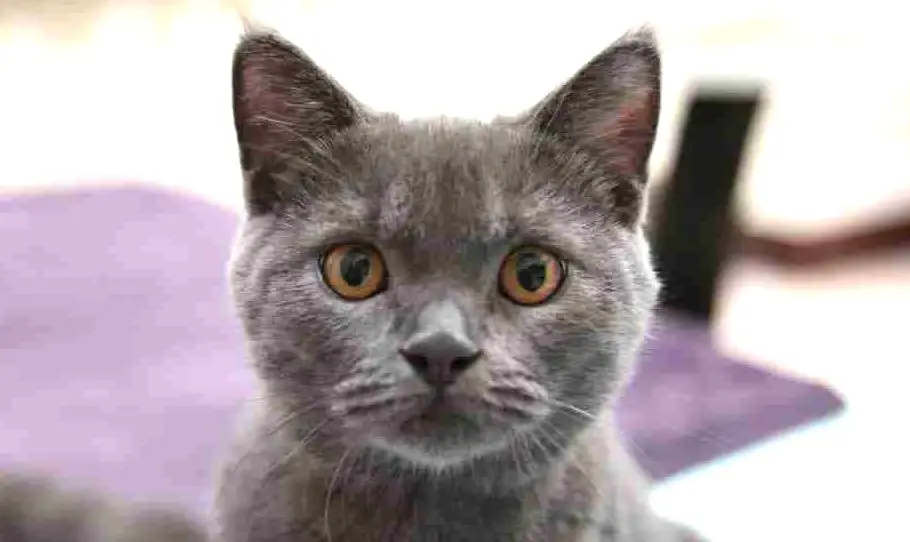
The Korat cat, as the name suggests, hails from Thailand from the Korat region. It shares a number of traits with siamese cats without being an exact grey replica.
It is easy to train, has low shedding characteristics, or at least appears that way due to its fine fur, has a sleek appearance, is a mid-size cat, is very friendly and attentive to people, is very intelligent, and likes to hang out socially with the family.
These cats are only recognized in the solid grey color scheme and have green eyes which tends to set them apart from the British blue and Chartreux. In fact, their eye color, slightly finer body shape, and heart-shaped face along with their more people-friendly attitude tend to make them recognizable from their European blue cousins.
If you want a grey shorthair cat that is friendly, actively seeks out company, can be trained to fetch and carry out fun tasks, is happy to be a lap cat or play vigorously with kids then the Korat is definitely worth considering.
Russian Blue
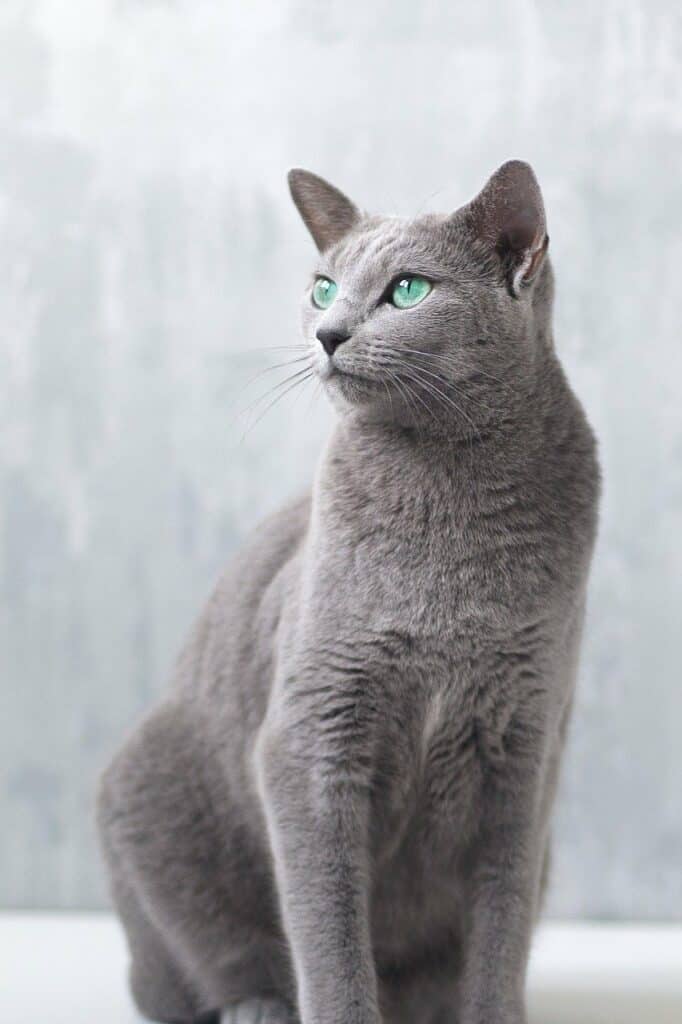
The Russian Blue cat is a natural breed that originates from Russia. They are thought to have been picked up by European sailors visiting northern Russia and brought back to the rest of Europe.
The Russian blue differs from other popular grey cats in so much as it has a distinctive wedge-shaped head and emerald green eyes.
It has a double coat, unlike the Korat cat with a single fine coat, and does not feature orange or amber eyes like the British shorthair or Chartreux. It is a mid-size cat, with pointed ears and a long slender body.
It has a temperament that is more like the Chartreux than the Korat. It is a quiet living cat that is not so active socially – they are renowned for picking one member of the household as their person, although they will approach and mingle with the whole household.
The Nebelung cat is a longhair grey cat descended from the Russian Blue.
Oriental Shorthair
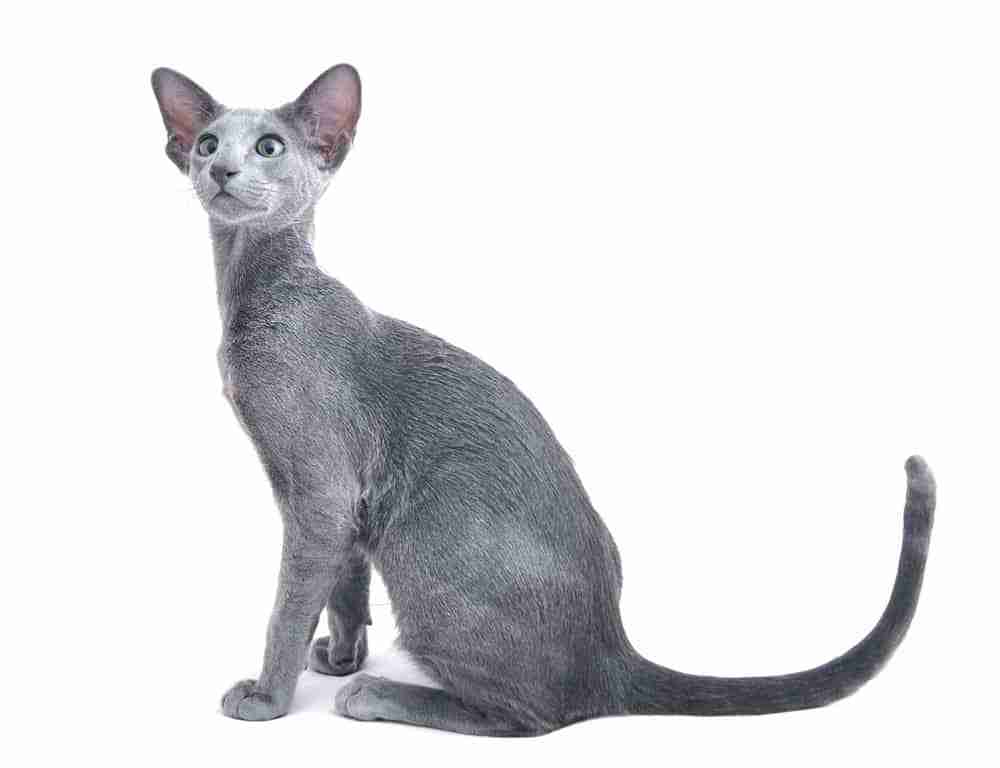
Essentially the Oriental shorthair cat is a siamese cat but in a variety of solid colors and patterns. They have been bred from siamese cats by breeders who actively sought out more color and pattern variations than that associated with the classic siamese cat – oriental shorthairs include tabby cats, solid color cats, and bicolor cats – there are over 300 different variations of breed color and pattern recognized.
However, they are recognized for being a breed that can produce a solid blue shorthair cat if that is what you seek.
They carry all the traits and aspects that you would expect to see in a siamese cat except the colorpoint coat pattern or blue eyes. They are athletic, sleek-looking cats with a very distinctive triangular head shape, large pointed ears, and almond-shaped eyes.
Siamese cats are known for their intelligence, sociability, and vocalization and grey oriental shorthairs are no different! If you want a full-on, active member of your family that will demand to be a part of the action, can get on with children, and loves company then this grey shorthair cat is probably a good choice for you!
Scottish Fold

The Scottish fold is a breed that originates from a single domestic shorthair cat that was employed as a barn cat on a Scottish farm in the 1960s. The cat was noted for having folded ears and an owl-like appearance. A number of scottish fold kittens inherited the mutated gene and went on to develop the folded ear look and this was how the breed came to start.
Unfortunately, the folded ear look, although popular, actually derives from a severe health problem – basically the production of cartilage and collagen is affected in the cat. This led to a number of cats being born with severe limb and tail deformities and the European cat associations revoked the registration of the breed in the early 1970s.
However, Scottish folds transported to America have been crossbred with British shorthair cats in an attempt to retain the folded ear look but eradicate some of the health problems associated with the breed. This crossbreeding has resulted in the breed becoming associated with shorthair grey cats.
These cats are now basically British shorthairs with folded ears!
Any Known Health Issues With Grey Shorthair Cats?
Luckily, there are no known health issues that arise from cats having short grey coats.
But, they do suffer from all the common ailments that your average domestic shorthair tabby cat would suffer from like kidney issues in older age, cardio issues, UTIs, hyperthyroidism, etc. But basically, their health status is unaffected by coat color!
Some specific cat breeds are known to have health issues associated with them and the big stand out on the above list are the Scottish Fold cats.
Scottish folds have come about due to a natural genetic mutation that gives them issues with the production of cartilage. This in turn produces the floppy, folded ear cat as the ear cartilage does not form as normal.
Unfortunately, cartilage is essential in joints and other areas of the body – which means Scottish Folds are known to have all sorts of problems with worn out, painful, arthritic joints – even at a very young age. This is a controversial breed.
How Much Does A Grey Shorthair Cat Cost?
A grey domestic shorthair tabby cat can be had for as little as $40. They are not noted for rarity or desirability (except maybe the most distinctive, sharply marked black and grey tabby cats).
A solid grey shorthair cat that is a Maltese or domestic shorthair simply comes up so rarely that a market price is not really available, but you would not be paying any more than a blue cat that is from a certified breed!
For a purebred gray cat like a Korat cat or a Russian blue, prices are likely to start from about $250 for a paper carrying, certified purebred and rise to $2500 for a purebred from show-winning stock!
Wrap Up
Grey shorthair cats come in a number of forms, the most common being the domestic shorthair grey tabby cat.
Solid grey cats are rarer than these tabby cats.
They are available as domestic shorthair cats but if your heart is set on such a cat, then you will find more luck sourcing a grey shorthair cat from one of the breeds that are specifically known for producing these cats.
If color and rarity are your top priority then go for a grey long hair cat as these are even more impossibly rare and unusual than a shorthair grey cat!
